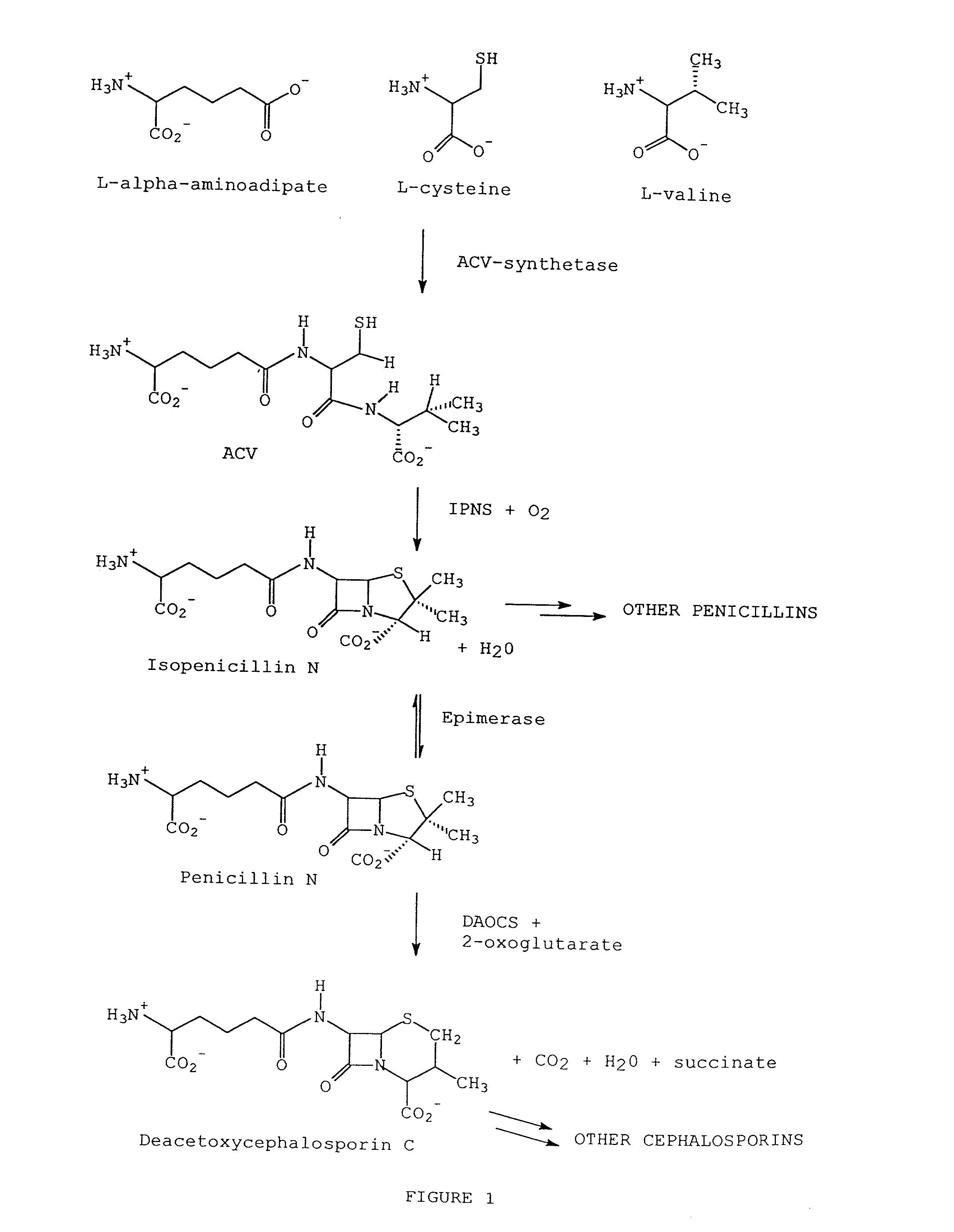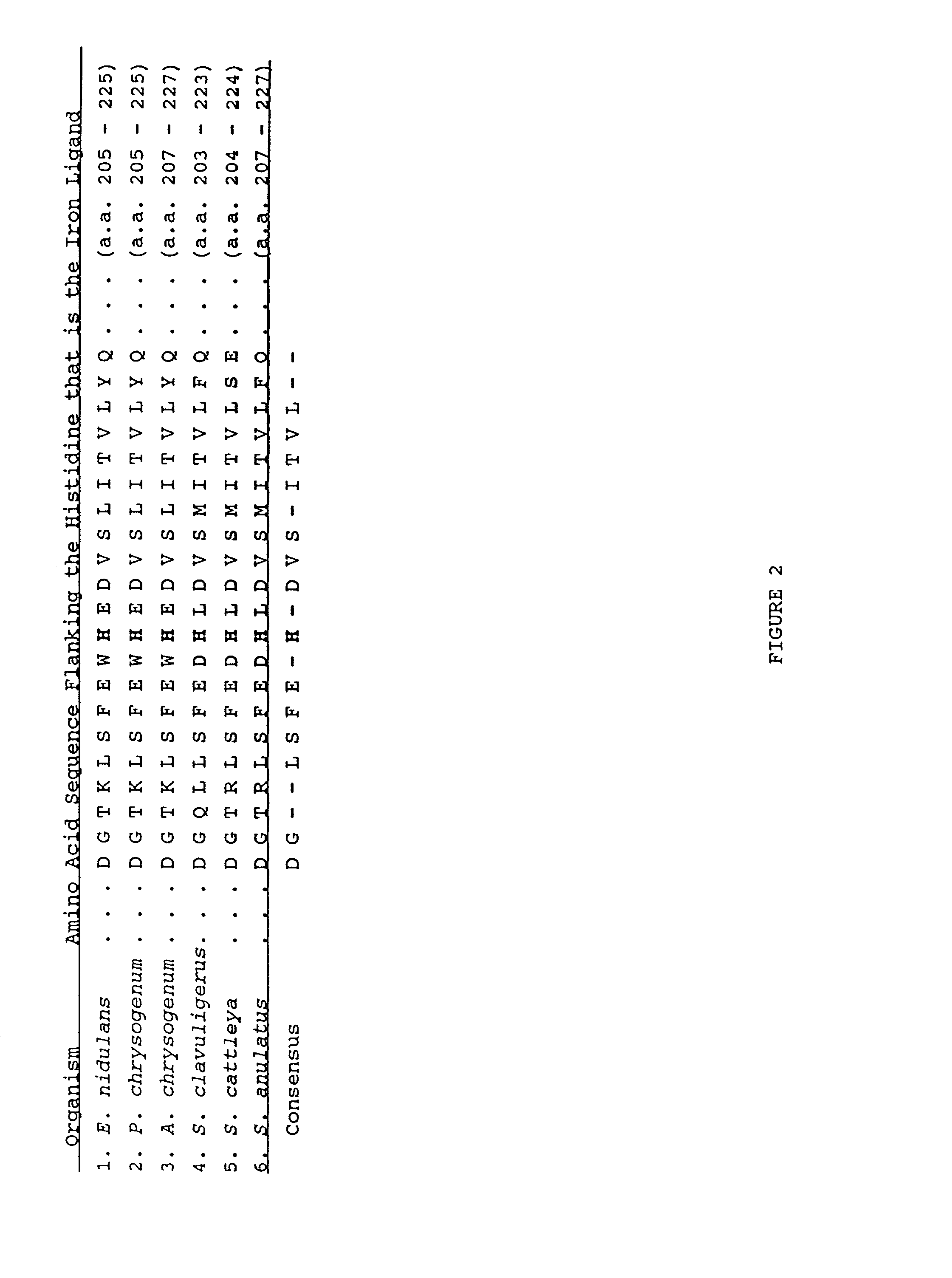[0052] Normally, in the production of an antibiotic by an antibiotic producing
organism in a culture, the enzymes involved in the pathway for the production of the antibiotic are continuously produced. However, various enzymes in the pathway are subject to
feedback inhibition, which as the amount of antibiotic accumulates, the rate and amount of antibiotic produced decreases. These enzymes, e.g., IPNS, DAOCS, and DAOCS / DACS, have very short half-life because they are particularly susceptible to catalytic and / or non-catalytic inactivation during the enzyme reaction. For example, IPNS, in the presence of its substrate and O.sub.2, Fe.sup.2+ and ascorbate is active for approximately 200 catalytic events before inactivation (Perry et al., Biochem. J. 255: 345-351 (1988)). Therefore, there is a limit as to how much antibiotic can be produced by an antibiotic producing
organism in a given culture. The
advantage of the present invention is that growing the modified organism expressing the modified enzyme that is bicarbonate-dependent in medium not supplemented with bicarbonate allows the modified organism to be grown to very high levels before bicarbonate is added to the medium to induce
antibiotic production. Therefore, the yield of antibiotic from a culture of modified organisms expressing the bicarbonate-dependent enzyme can be higher than the yield that can be achieved with organisms expressing the native enzyme. The present invention can further allow the use of these modified bicarbonate-dependent enzymes in a
cell-
free system wherein the enzymes are immobilized on a matrix. Production of antibiotic in the
cell free system is regulated by the presence or absence of bicarbonate.
[0053] Isopenicillin N synthetase (IPNS), deacetoxycephalosporin C synthetase (DAOCS), and the
bifunctional enzyme, deacetoxycephalosporin C synthetase / deacetylcephalosporin C synthetase (DAOCS / DACS), are all members of the same
protein structural family; the non-
heme Fe(II) dependent family of oxygenases and oxidases, which also includes 1-aminocyclopropane-
carboxylic acid (ACC) oxidase. IPNS, DAOCS, and DAOCS / DACS are important in the production of penam and cepham based antibiotics, and ACC oxidase catalyzes the conversion of 1-aminocyclopropane-1-
carboxylic acid (ACC) to
ethylene, a
plant hormone of great significance to
agriculture. ACC oxidase, IPNS, DAOCS, and DAOCS / DACS all require
ascorbic acid as a co-substrate for activity. Even though these enzymes are from the same family, there are several functional differences between these enzymes. For example, ACC oxidase requires
carbon dioxide or bicarbonate as an activator; whereas, IPNS, DAOCS, and DAOCS / DACS do not. Also, DAOCS and DAOCS / DACS require 2-oxo-gluterate as a
cofactor in the reaction whereas IPNS and ACC oxidase do not. However, despite these differences, sequence comparisons of ACC oxidases with IPNS and other members of the family of 2-oxoglutarate Fe(II) dependent dioxygenases have shown that an aspartate and two histidine residues are completely conserved throughout this
subfamily of Fe(II) dependent oxygenases / oxidases. Further, two completely conserved histidine and aspartate residues in ACC were shown to act as Fe(II) ligands (Zhang et al. Biochem. 36: 15999-16007 (1997); Kadyrzhanova et al. in
Biology and
Biotechnology of the
Plant Hormone Ethylene, (1997) Kanellis et al. (eds.), Kluwer Academic Publishers, Netherlands, pp. 5-13). These two histidine residues and the
aspartic acid residue is an example of the 2-histidine-1-aspartic acid trifacial motif (Hegg and Que, Eur. J. Biochem. 250: 625-629 (1997)).
[0054] There are seven Arg residues that are conserved among the 38 known ACC oxidases. Of these seven, only three are in positions likely to affect enzyme activity. These are Arg244, Arg299, and Arg175. Arg244 in concert with
Serine (Ser) at position 246 (Ser246) forms one of the binding sites for the ACC wherein the Ser246
hydrogen bonds to the ACC carboxyl group. The equivalent residues in the
Aspergillus nidulans IPNS are Arg279 and Ser281 which bind the D-valinyl carboxyl group of .
delta.-(L-.alpha.-aminoadipyl)-L-cysteinyl-D-
valine (ACV). Since ACC is recognized by ACC oxidase as a D-amino acid, this further shows the similarity of the mechanisms used by ACC oxidase and IPNS in binding their respective substrates. Showing that Arg175 is the essential Arg residue in ACC oxidase was done by covalently modifying Arg residues with 1,2-cyclohexanedione (CHD) and demonstrating that the covalently attached CHD caused almost a complete loss of ACC oxidase activity when CHD was covalently attached to Arg175. Micro-sequencing of CHD-modified ACC oxidases will confirm that for the inactivated CHD-modified ACC oxidase, Arg175 carries the CHD
adduct.
[0055] It had been widely accepted that CO.sub.2 was the activator for ACC oxidase activity; however, the inventors have determined that ACC oxidase activity is activated by bicarbonate (HCO.sub.3.sup.-) and not the gas CO.sub.2. In the
active site of ACC, the bicarbonate becomes a ligand that is
hydrogen or electrostatically bonded to the guanido group of an
arginine (Arg) at position 175 (Arg175) such that one
oxygen and the .sup.-OH group of bicarbonate is associated with the guanido group and the other
oxygen (O.sup.-) is placed in close proximity to the catalytic iron atom and to its substrate ACC which is in the reaction center of the enzyme. The
oxygen atom (O.sup.-) serves as the base catalyst to abstract protons from the ACC amino group in the oxidation of ACC to
ethylene. The Arg175 in ACC oxidase is two amino acids upstream of the His residue (His177) which is the iron ligand for the enzyme.
[0056] Modified ACC oxidases have been made that have the Arg175 of the oxidase replaced by glutamate (Glu),
glutamine (Gln),
lysine (Lys),
glycine (Gly) or histidine (His). Another modified ACC oxidase Arg175 to
alanine (Ala) is being made. It is believed that the Arg175 to Ala and the Arg175 to Gly modified ACC oxidases will be inactive or will require 2-oxo-acids for activity as is true for DAOCS and DAOCS / DACS which have an Ala and Gly residue, respectively, in the equivalent position. However, when the inventors modified the ACC oxidase Arg175 to Glu, Gln, or His by
site directed mutagenesis, the Km for bicarbonate in the reaction was increased by about 40-fold and the Vmax for the reaction was reduced by approximately 96%. Glu is not capable of
hydrogen bonding to bicarbonate. Both the Gln and His are capable of hydrogen bonding bicarbonate; however, they did not bind as effectively as the Arg175, and bicarbonate activation was not saturable. When the ACC oxidase Arg175 was modified to lysine (Lys), the modified ACC oxidase was about 25% as active as the native ACC oxidase, and bicarbonate activation was saturable. The Lys epsilon amino group is known to bond well to or interact with CO.sub.2 or bicarbonate. It is suspected that the reason for the decreased effectiveness is that the placement of the bicarbonate near the iron center by either the Gln residue's
amide-bicarbonate
adduct or the His residue's
imidazole-bicarbonate
adduct may not be as favorable as the Arg's guanido-bicarbonate adduct. In contrast, substituting Glu for Arg175 produced an ACC oxidase that was not able to catalyze the reaction. The low non-saturable activation of the Arg175 to Glu modified ACC oxidase can be explained by non-enzyme bound bicarbonate interacting directly with the Fe(II)ACO-ACC-O.sub.2
ternary complex.
[0057] Finally,
computer simulation models indicate that Arg175 of ACC oxidase may rotate within 8 angstroms (.ANG.) of the catalytic iron atom. This modeling was done by mutating the
Aspergillus nidulans IPNS Glu212 to Arg212 by employing the X-
ray coordinates of the IPNS. However, definitive proof that Arg175 in ACC oxidase is within 8 .ANG. of the catalytic iron atom must await until the structure of ACC oxidase has been determined by X-
ray crystallography. However, secondary
structure analysis by
multiple sequence alignment indicates that Arg175 of ACC oxidase is positioned like the Glu212 of IPNS or the Ala181 in DAOCS suggest that the
computer simulation model of ACC oxidase is correct.
 Login to View More
Login to View More  Login to View More
Login to View More 

